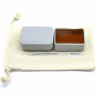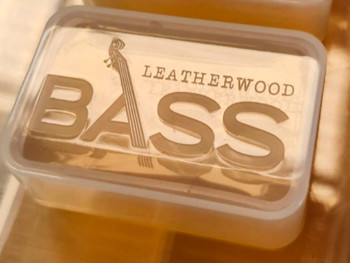Leatherwood
Leatherwood "Bespoke" Amber Bass Rosin (2-pack)
We ship worldwide! (Read this)
Add our "Rosin Humidor" (see below) to keep your new rosin fresh - and get $4 off!
Discount shown in cart.
("Small" Model recommended for this rosin)
- Bow Accessory:
- This item ships FREE (USA) in a cart totaling $100 or more
Description
This is some pretty special rosin. I'd hope so, at this pricing! They call it "Bespoke" - meaning "customized" - because you get to mix and match several different hardness/grades to get exactly the feel that you need for your style of play.
The rosin ingredients we are use are derived from pure pine resin.
 You get a 2-pack - so choose two recipes from the range of recipe grades (see recipe chart graphic for explanations). From hard and crisp rosins to soft and sticky rosins, each of these recipes best suit specific playing styles and conditions. And, you might find your ideal recipe is a mix of a harder and softer grade. This is why we provide 2 recipes per pack. You can blend them on the bow effectively by alternating swipes.
You get a 2-pack - so choose two recipes from the range of recipe grades (see recipe chart graphic for explanations). From hard and crisp rosins to soft and sticky rosins, each of these recipes best suit specific playing styles and conditions. And, you might find your ideal recipe is a mix of a harder and softer grade. This is why we provide 2 recipes per pack. You can blend them on the bow effectively by alternating swipes.
According to the manufacturer, these rosins do not dry out like other rosins and one recipe would last 1-2 years with intensive playing. Players report that it plays cleanly - no powder all over the strings, and no flaking.
Key:
The higher the percentage the softer the rosin. Firstly work out what type of playing context you want the recipe for, then pick a higher grade if you are in a colder or dryer climate, or a lower grade if you are in a hotter or more humid climate. For example. In Singapore or Mexico, the 60% might be too soft in those hot climates, and these rosins may be more like a liquid, so a 40% recipe would be more ideal here. However in Scandinavia (very cold and dry climates) the 60% will be harder and not as soft, therefore ideal.
Some players have made comparisons to popular rosins; players found that the 30-40% range seemed similar to a popular rosin from Sweden; whereas 40-50% was similar to a US-made rosin that is well known for its soft adhesion, while being grippy but not as aggressive. So if you're using one of those rosins, and want to start with something familiar, those comparisons might be helpful.
-
- 20% - This harder rosin offers clear and consistent lyrical quality particularly in higher registers. A crisp bite to the string allows for clarity in articulation in solo contexts.
- 30% - While maintaining the lyrical qualities of the harder solo rosin, this recipe offers a little more "stick" at the beginning of the note allowing for greater projection when needed.
- 40% & 50% - Heavy Orchestral. Much softer and stickier, these rosins are designed to offer superior strength of "stick" and power, particularly for the lower or extended strings.
- 60% - Baroque (open gut). This very soft and sticky recipe allows the gut string to be grabbed with reliable strength, and the lower traction allows the string to vibrate freely without restraint.
- 20% - This harder rosin offers clear and consistent lyrical quality particularly in higher registers. A crisp bite to the string allows for clarity in articulation in solo contexts.
To buy:
Use the recipe grade chart (in the photos, above) to choose your desired recipes (2 per pack). They can be the same recipe or different recipes. Select the two that you want, and add to cart. Simple!
To use:
When you receive your rosin:
- Carefully separate the walls of the rubber cup from the rosin
- Lift the rosin slightly out of the cup or peel down sides of cup
- Keep your fingers touching the sides of the cup, not the rosin
- Apply with fast and strong bow strokes, with heavy pressure on the rosin.
- Swipe towards the centre of the rosin to avoid chipping
- For best use, apply 2 - 5 swipes as required.
- To melt your rosin back into shape, just sit it in the cup on a flat surface in a warm environment or window sill and it will gradually melt back into the shape of the cup. Then allow it to cool and harden before using again
A note about "old formula" vs. "new formula" concerns:
There are a few threads on bass message boards, concerning some changes that apparently occurred between the initial release of the Leatherwood rosin to the current rosin formula. We have reached out to our Leatherwood rosin distributor for clarification, and were told, "Andrew, the owner and rosin maker, assured us that his new recipes were released in March 2020, and that there is no chance we accidentally received a old batch. The older recipes that reportedly had some issues are long gone."
You can be confident that all of the Leatherwood rosin we have (we started carrying Leatherwood some 7 months after the new recipes were developed) are the most recent, updated formula. And, like all of our rosins, we rotate stock to ensure that no one ever gets an old, stale cake.
Video
4 Reviews
-
Waste of money
Very disappointed, total waste of money. I’ve been trying this stuff for several months. So surprised at the other reviews - maybe I received a bad lot. I have the 40 and 50 percent. Constantly wiping powder off the strings, difficult to get a consistent attack. Been using Pops and Carlsson for many years. Wasted $62 on the Leatherwood - it’s going in the trash. Back to what has always worked - Pops and Carlsson.
-
50% vs POPS
I got this rosin because I was not happy with the POPS "general playing" rosin. The biggest advantage for me is that now my bowing volume matches my plucking volume. With the POPS' there was significant volume increase when I would switch over to the bow. Other benefit over the Pops is a more even tone throughout the length of the bow. The 50% that I am now using does not have the real harsh attack that the Pops has and the rosin also doesn't create spots on the bow that end up having more grip than other spots. This was a major issue for me. Now I have a lot less issues with overtones popping up. I get a much cleaner and more consistent fundamental. I am not playing out much right now so all of my playing is in my temperature and humidity controlled studio. I generally keep it at 72 to 78 degrees and 45-52% humidity. The one drawback, if it could even be considered as such, is that I have to take quite a few more swipes to get enough rosin on the bow than I had to with the POPS'. Although I should add that applying the rosin is a lot easier. Having to deal with the paper cupcake wrapper of the POPS was a real pain.
-
Leatherwood bespoke rosin
I got 30% and 40% since I live in a moderate California climate. The rosin produces a very nice sound but it doesn’t project as well as pops does for me, so I’ll keep using pops for orchestral work. That said, for chamber and solo playing the 30% really shines. I wouldn’t purchase if you were solely going to use it for heavy orchestral playing.
-
Leatherwood Bespoke Bass Rosin
I ordered the 40% and 50% 2-pack and am thoroughly pleased with the product. I started with the 50%, since it's 0 degrees at present. It produced a clear, clean, and even sound. The start was immediate with a DeLuccia bow and a 4/4 Viennese five-string bass strung with Perpetual strings. The voice was aggressive but not harsh. There was no ancillary noise, the tone was even and strong throughout the dynamic range with an easy start from tip to frog. Off-string techniques were clean and articulate. There was no dust, chalking, or bothersome residue on either bass or bow after an hour of play time. I switched to a Les Korus bow to try the 40% with much the same result. The differences included a more nuanced color palette with an assertive rather than aggressive tone. Both performed well on Bach and classical rep, but the 50% was a better suit to heavy orchestral work. i feel that this rosin is well worth your attention if you seek both ease and excellence of tone.









